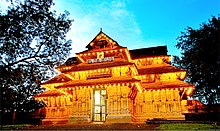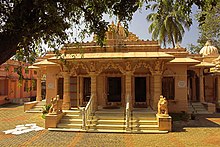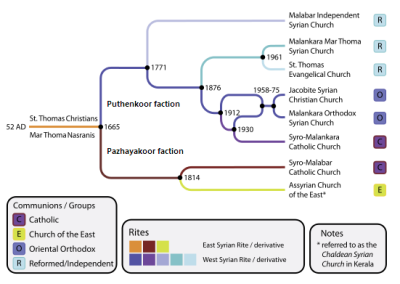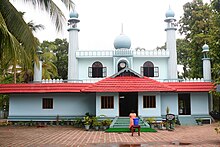Religion in Kerala: Difference between revisions
| Line 49: | Line 49: | ||
===Hinduism=== |
===Hinduism=== |
||
[[File:Vadakkumnathan Temple.jpg|thumb|[[Vadakkunnathan Temple]] dedicated to [[Shiva]] at [[Thrissur]]]] |
[[File:Vadakkumnathan Temple.jpg|thumb|[[Vadakkunnathan Temple]] dedicated to [[Shiva]] at [[Thrissur]]]] |
||
The mythological legends regarding origin of Kerala are essentially Hindu in nature. Many influential saints and movements hail from Kerala. [[Adi Shankara]] was a leading [[Brahmin]] philosopher who contributed significantly to Hinduism in India and propagated philosophy of [[Advaita]]. He was instrumental in establishing four [[matha]]s at [[Sringeri]], [[Dvaraka]], [[Puri]] and [[Jyotirmath]]. [[Melpathur Narayana Bhattathiri]] was the other leading Brahmin religious figure who composed [[Narayaniyam]], a collection of verses in praise of [[Krishna]]. Another notable philosopher and reformer was [[Narayana Guru]]. His movement for social reform and eradication of caste based discrimination helped to establish Kerala as one of the most socially progressive states in India. Hindus in Kerala are divided into various castes such as [[Nambudiri]]s, [[Nair]]s, [[Ezhava]]s, and [[Dalit]]s. Kerala was the first region in India which allowed Hindus of any caste to enter and worship in temples ([[Temple Entry Proclamation]]). |
|||
Various practises of Hinduism are unique to Kerala and are not followed in other parts of India. Different cults of [[Shiva]] and [[Vishnu]] are popular in Kerala. Malayali Hindus also worship [[Bhagavathi]] as a form of [[Shakti]]. Almost every village in Kerala has its own local guardian deity, usually a goddess. Hindus in Kerala also strongly believe in power of snake gods and usually have sacred snake groves known as ''[[Sarpa Kavu]]'' near to their houses.<ref>[http://www.hinduonnet.com/thehindu/quest/200201/stories/2002011202710200.htm ]{{dead link|date=August 2011}}</ref> |
Various practises of Hinduism are unique to Kerala and are not followed in other parts of India. Different cults of [[Shiva]] and [[Vishnu]] are popular in Kerala. Malayali Hindus also worship [[Bhagavathi]] as a form of [[Shakti]]. Almost every village in Kerala has its own local guardian deity, usually a goddess. Hindus in Kerala also strongly believe in power of snake gods and usually have sacred snake groves known as ''[[Sarpa Kavu]]'' near to their houses.<ref>[http://www.hinduonnet.com/thehindu/quest/200201/stories/2002011202710200.htm ]{{dead link|date=August 2011}}</ref> |
||
Revision as of 15:18, 20 October 2013

Religions in Kerala are a mixture of different faiths, most significantly Hinduism, Islam and Christianity. Kerala has a reputation of being, communally one of the most tolerant states in India. According to the 2001 Census of India figures, 56% of Kerala residents are Hindus, 24% are Muslims, 19% are Christians, and the remaining follow other religions including Sikhism, Jainism, Buddhism, Judaism.[1] Various tribal people in Kerala have retained various religious beliefs of their ancestors. class="wikitable "
Table : Percentage distribution of population according to community by district (The statistics are based on a sample survey in 1998).[2]
| District | SC/ST | Nairs | Ezhavas | Syrian Christians | Latin Christians | Muslims | Others | Total |
|---|---|---|---|---|---|---|---|---|
| Thiruvananthapuram | 11.3 | 13.2 | 24.9 | 1.4 | 23.7 | 15.3 | 10.2 | 100 |
| Kollam | 16.7 | 24.5 | 16.7 | 3.6 | 13.6 | 14.2 | 10.7 | 100 |
| Pathanamthitta | 8.6 | 11.0 | 13.5 | 49.0 | 9.5 | 1.3 | 7.1 | 100 |
| Alappuzha | 7.6 | 13.7 | 39.3 | 13.7 | 2.9 | 7.0 | 15.8 | 100 |
| Kottayam | 8.2 | 8.8 | 21.1 | 29.2 | 10.9 | 11.9 | 9.9 | 100 |
| Idukki | 14.3 | 7.6 | 15.4 | 26.2 | 12.8 | 5.4 | 18.3 | 100 |
| Ernakulam | 7.4 | 8.0 | 14.3 | 13.4 | 21.3 | 22.7 | 12.9 | 100 |
| Thrissur | 8.7 | 8.2 | 24.3 | 23.9 | 10.8 | 15.5 | 8.6 | 100 |
| Palakkad | 14.2 | 10.3 | 22.9 | 0.9 | 3.8 | 32.3 | 15.6 | 100 |
| Malappuram | 5.3 | 1.8 | 8.3 | 0.5 | 3.9 | 75.3 | 4.9 | 100 |
| Kozhikode | 4.9 | 13.7 | 31.4 | 0.9 | 0.4 | 41.8 | 6.9 | 100 |
| Wayanad | 16.3 | 16.3 | 19.8 | 17.0 | 3.2 | 17.0 | 10.4 | 100 |
| Kannur | 3.5 | 19.5 | 30.3 | 3.6 | 0.7 | 27.5 | 14.9 | 100 |
| Kasargod | 8.0 | 2.1 | 13.6 | 0.1 | 2.3 | 47.0 | 26.9 | 100 |
| Kerala | 9.1 | 11.1 | 21.6 | 14.25 | 5.65 | 26.8 | 11.5 | 100 |
Indian religions
Hinduism

The mythological legends regarding origin of Kerala are essentially Hindu in nature. Many influential saints and movements hail from Kerala. Adi Shankara was a leading Brahmin philosopher who contributed significantly to Hinduism in India and propagated philosophy of Advaita. He was instrumental in establishing four mathas at Sringeri, Dvaraka, Puri and Jyotirmath. Melpathur Narayana Bhattathiri was the other leading Brahmin religious figure who composed Narayaniyam, a collection of verses in praise of Krishna. Another notable philosopher and reformer was Narayana Guru. His movement for social reform and eradication of caste based discrimination helped to establish Kerala as one of the most socially progressive states in India. Hindus in Kerala are divided into various castes such as Nambudiris, Nairs, Ezhavas, and Dalits. Kerala was the first region in India which allowed Hindus of any caste to enter and worship in temples (Temple Entry Proclamation).
Various practises of Hinduism are unique to Kerala and are not followed in other parts of India. Different cults of Shiva and Vishnu are popular in Kerala. Malayali Hindus also worship Bhagavathi as a form of Shakti. Almost every village in Kerala has its own local guardian deity, usually a goddess. Hindus in Kerala also strongly believe in power of snake gods and usually have sacred snake groves known as Sarpa Kavu near to their houses.[3]
The most popular temples amongst Hindus in Kerala are Vadakkunnathan Temple, Guruvayur Temple, Sabarimala, Sree Poornathrayesa Temple, Kodungallur Bhagavathy Temple, Chottanikkara Temple, Rajarajeshwara Temple and Padmanabhaswamy Temple. Some of these temples have various dress code restrictions. For e.g., in Sabarimala, it is prohibited for women between the age of 12–50 years to visit the temple. Temples in Kerala follow elaborate rituals and only priests from the Nambudiri caste can be appointed as priests in major temples. These priests are assisted by a caste known as Ambalavasis. Hindu women keep their head uncovered in temples, but its not a strictly followed custom.
Malayali Hindus have unique ceremonies such as Chorunu (first feeding of rice to a child) and Vidyāraṃbhaṃ[4] (beginning of education of a child). Marriages amongst Hindus in Kerala are a very simple affair as compared to other parts of India.

Hindus in Kerala usually cremate their dead at the southern end of their house. Unlike in other parts of India, daughters also take part in various rituals after cremation. (See picture on left)
- Festivals
The major festivals amongst Hindus in Kerala are Onam and Vishu, though the former is more of a pan-Kerala festival. Other festivals include Maha Shivaratri, Krishna Janmashtami, Diwali and temple festivals like Pooram, Thaipusam, Bharani, Nemmara Vallangi Vela, Mamankam festival, Radosthsavam, Thalapoli, Pongala, Ekadashi etc. Thrissur Pooram, Guruvayur Ekadasi and Nemmara Vela are some of the more prominent amongst these.
Buddhism
Images have been discovered in the coastal districts of Alleppey and Quilon; the most important Budti Kuttan near Ambalappuzha.[citation needed] Buddhism probably flourished for 200 years (650-850) in Kerala. The Paliyam Copper Plate of the Ay King, Varaguna (885-925 AD)[5] shows that the Buddhists enjoyed some royal patronage even in the tenth century. The Buddha idol, at Mavelikkara, shows the clear roots and importance of Buddhist religion in Kerala. The idol of Buddha at Mavelikara is four feet tall, and is perhaps the biggest such statue in Kerala. The statues is in seated posture, resembling Padmasana. A feature common to the idols is that hair has not been engraved on the head.
The decline of Buddhism started in the eighth century with the revival of the Brahminical religion. Buddhism faded away gradually and completely disappeared during the reign of the Vaishnavite Kulasekharas in the 11th century.
What actually happened was that Buddhism was reabsorbed into Hinduism, from which it broke away. Many Keralites, like the Ezhavas, who were once supposed to be Buddhists immigrants from Sri Lanka and local converts, gradually embraced Hinduism.
Buddhism has left its impact on Kerala. Kerala temples show traces of Buddhist art and architecture. Amarasimha, the author of the popular Sanskrit text-book used in Kerala schools until recently, was a Buddhist. Kumaran Asan, the great Kerala poet, was influenced by the great Buddhist religion and wrote the famous, Buddhist poems: Karuna. Chandala Bhikshuki, and Sri Buddha Charitam.
Jainism

Jainism, which arrived in Kerala around the 3rd century BC, has a significant population in the Wayanad district bordering the Karnataka state. The Jain religion was brought to the South in the third century BC by Chandragupta Maurya (321-297 BC) and the Jain saint Bhadrabahu, according to Jain traditions. They came to Sravanabelgola in Mysore. The Jains came to Kerala with the rest of the Chera immigrants starting in the sixth century. Amongst the existing original Jain temple in Kerala, the most prominent is popularly known as Jainmedu is in Vadakkanthara village, which is about 3 km from Palakkad. This temple was reportedly built by Inchanna Satur. This indicates significant population of Jains lived in Palaghat during the 15th century. Later various members of Marwari business community have built Jain temple in Kochi. Remnants of Jain temple known as Chathurmukha Basti is a popular destination in Manjeshwaram, Kasaragod.[6] Some historians claim many Hindu temples might have been once Jain temples. Several places in Wyanad have Jain temples -an indication that North Malabar was once a flourishing center of Jainism. Historians believe that the decline of Jainism started about the eighth century. Jainism seems to have completely disappeared from Kerala by the sixteenth century; the foreign visitors from Europe do not mention the Jains at all. At present, Jainism in Kerala has a very small following, mainly amongst the original Jains of Kerala and the North Indian business community, settled in and around Kochi and Calicut.
Tribal and other religious faiths
Various groups classified as tribes in Kerala still dominate various remote and hilly areas of Kerala.[7] They have retained various rituals and practices of their ancestors despite influences of mainstream religions.
Abrahamic Religions
Judaism

Judaism arrived in Kerala with spice traders, possibly as early as the 7th century BC.[8] There is no consensus of opinion on the date of the arrival of the first Jews in India. The tradition of the Cochin Jews maintains that after 72 AD, after the destruction of the Second Temple of Jerusalem, 10,000 Jews migrated to Kerala.[8]
The only verifiable historical evidence about the Kerala Jews goes back only to the Jewish Copper Plate Grant of Bhaskara Ravi Varman in 1000 AD.[9] This document records the royal gift of rights and privileges to the Jewish Chief of Anjuvannam Joseph Rabban. According to some historians, St. Thomas found first converts in Kerala to his new religion amongst many of the Cochin Jews. However these Jews who accepted Christianity retained the Aramaic language once spoken by Jews in Middle East. Their descendants form the core of Syrian Christian (Syrian Malabar Nasrani) community in Kerala. Later in 16th century many Jews from Portugal and Spain settled in Cochin. These Jews were called white Jews as opposed to the native black Jews.
The Portuguese did not look favorably on the Jews. They destroyed the Jewish settlement in Cranganore and sacked the Jewish town in Cochin and partially destroyed the famous Cochin Synagogue in 1661. However, the Dutch were more tolerant and allowed the Jews to pursue their normal life and trade in Cochin. According to the testimony of the Dutch Jew, Mosss Pereya De Paiva, in 1686 there were 10 synagogues and nearly 500 Jewish families in Cochin. Later Britishers too were tolerant, and the Jews enjoyed peace and protection. After the creation of the State of Israel in 1948, most Jews decided to emigrate to Israel. Most of the emigrants to Israel between 1948 and 1955 were from the community of black Jews and brown Jews; they are known as Cochini in Israel. Since 1960s only few hundred Jews (mostly white Jews) remained in Kerala with only two synagogues open for service: the Pardesi Synagogue in Matancherry built in 1567 and the synagogue in Parur.
Today the number of the Jews in Kerala has dwindled down to few dozens; most of them are elderly people.
Christianity


Syrian Christians in Kerala are also called Nasranis. The works of scholars and Eastern Christian writings say that Thomas the Apostle visited Muziris in Kerala in 52 AD to proselytize amongst Kerala's Jewish settlements and from this came Thomasine Christianity.[10][11] The 3rd and 4th centuries saw an influx of Jewish Christians from the Middle East. Knanaya communities arrived during this time.[12] Syrian Christians remained as an independent group, and they got their bishops from Assyrian Church of the East until the advent of Portuguese and British colonialists. The arrival of Europeans in the 15th century and discontent with Portuguese interference in religious matters fomented schism into Catholic and Orthodox communities. Further schism and rearrangements led to the formation of the other Indian Churches. Latin Rite Christians were converted by the Portuguese in the 16th and 19th centuries from lower castes where fishing was the traditional occupation. Anglo-Indian Christian communities formed around this time as Europeans and local Malayalis intermarried. Protestantism arrived a few centuries later with missionary activity during British rule. It is important to note that despite being a heterogeneous group, Malayali Christians find unity in a common history and faith. Various denominations/Churches exist amongst Christians of Kerala.
There are around 20,000 Jehovah's Witnesses.[citation needed]
Some Catholic parishes in Kerala support large families with free schooling, medical care and cash bonuses to increase their religious population.[13] One parish offers 10,000 Rupees for every fifth child born.[14]
Islam

Muslims are generally referred to as Mappilas in Kerala. They form 24.3% of the population of Kerala. They share a common language (Malayalam) with the rest of the population and have a culture commonly regarded as the Malayalam culture of Kerala with an Arabian blend.[15] The general consensus among historians is that Islam arrived in Kerala through Arab traders either during the time of Muhammad himself (AD 609 - AD 632) or in the following few decades. Kerala has a very ancient relation with the middle east even during the Pre-Islamic period. Muslim merchants (Malik, son of Dinar) settled in Kerala by the 8th century AD and introduced Islam.
Later the Zamorin of Kozhikode allowed the Arab Muslim traders to settle and form a major community in Kozhikode, from where the religion gradually spread in the following centuries. Significant populations of Muslims live in Calicut, Malapuram districts in the Malabar region. Noted historian A. Sreedhara Menon opines that the policy followed by the Zamorins of encouraging Muslim traders to settle down in his kingdom to flourish maritime trade perhaps accounts for the relatively high proportion of Muslims in Malabar. The Muslims also manned the Zamorin's navy and were so intensely pro-Zamorin that one of them issued an order to bring up one male member in every fishermen family in his kingdom as a Muslim so as to get sufficient numbers in his navy.[16] There is also a significant Muslim population living in the coastal regions of central and southern Kerala.
Historians also believe that during invasion of North Kerala by Tipu Sultan, he forcefully converted many Hindus to Islam.[17][18] In a letter Tipu sent to one of his generals he claims to have converted over four lakh Hindus.
Since Islam reached Malabar as early as 7th century it had almost mixed with the culture and traditions of the people of Kerala and Hinduism. So, the Islahi movements of Kerala (a part of the renaissance of the community) after the Malabar Rebellion of 1921, produced a Salafi sect known as Kerala Nadvathul Mujahideen from the Sunnis of Kerala. In later years, both these branches split multiple times to produce complicated branches and sects.
Muslims in Kerala enjoy a better social and financial security when compared to Muslims living in other parts of India. Kerala's Muslim population is the fastest growing sect in Kerala. Muslims formed only 20 of Kerala population in 1971, but due to high population growth rate it increased to 24.3% of population as of 2001.[19]
Religious tensions
Despite Kerala having a reputation of being one of the most tolerant states of India, there have been religious conflicts. In the Mappila riots of 1921, Muslim Mappilas forcibly converted many Hindus and killed or drove away all Hindus who would not apostatise, totalling to one lakh (100,000).[20] The worst since 1980 was the Marad massacre in Kozhikode district in 2003, where eight Hindus were killed by an armed Muslim mob.[21][22] The 1992 Ayodhya-Babri Masjid incident also had repercussions in Kerala.[23] In 1983 there was an incident in Nilackal near Sabarimala[24] over discovery of a Cross. However during Nilackal incident no major violence was reported. Lately however various extreme religious groups have become influential in Kerala.[25][26] In 2008 there was tension in streets of Kerala over introduction of a seventh standard textbook. The controversy was about a chapter in the book Mathamillaatha Jeevan (Jeevan, without caste). Jeevan refused to belong to any religion or caste.[27] Various groups alleged that this book was atheistic anti-religious propaganda by ruling Left Front government.[28][29]
See also
References
- ^ "Census of India". Retrieved 2009-04-12.
- ^ Zachariah, Kunniparampil Curien; Mathew, Elangikal Thomas; Rajan, Sebastian Irudaya (2003). Dynamics of migration in Kerala: dimensions, differentials, and consequences. Orient Longman. p. 90. ISBN 978-81-250-2504-7.
- ^ [1][dead link]
- ^ "Vidyarambham celebrated in Kerala - India News - IBNLive". Ibnlive.in.com. Retrieved 2011-08-24.
- ^ A social history of India S. N. Sadasivan APH Publishing, 2000
- ^ Chathurmukha Basti, Kasaragod Malayala Manorama: Tuesday, November 29, 2005
- ^ Idukki - People and culture - Tribes
- ^ a b Katz 2000; Koder 1973; Thomas Puthiakunnel 1973; David de Beth Hillel, 1832; Lord, James Henry 1977.
- ^ "Sharon delighted with gift from Kochi". The Hindu. Chennai, India. September 11, 2003.
- ^ Medlycott, A E. 1905 "India and the Apostle Thomas"; Gorgias Press LLC; ISBN
- ^ Thomas Puthiakunnel, (1973) "Jewish colonies of India paved the way for St. Thomas", The Saint Thomas Christian Encyclopaedia of India, ed. George Menachery, Vol. II.
- ^ Mundadan AM (1984). Volume I: From the Beginning up to the Sixteenth Century (up to 1542). History of Christianity in India. Church History Association of India. Bangalore: Theological Publications.
- ^ "Catholic church in India wants followers to have more children, offers help for large families". Daily News. New York. 2011-10-11. Retrieved 2012-03-16.
- ^ "Church offers cash for kids in India". The New Zealand Herald. 2011-10-21. Retrieved 2012-03-2012.
{{cite news}}: Check date values in:|accessdate=(help) - ^ Pg 461, Roland Miller, The Encyclopaedia of Islam, Vol VI , Brill 1988
- ^ Pg 112, A short survey of Kerala History, A. Sreedhara Menon, Vishwanathan Publishers 2006
- ^ Tipu Sultan: villain or hero? : an anthology(Page 38)by Sita Ram Goel
- ^ Tipu in a letter to Badroos Saman Khan (dated January 19, 1790) admits I have achieved a great victory recently in Malabar and over four lakh Hindus were converted to Islam. I am now determined to march against the cursed Raman Nair (Dharma Raja Karthika Thirunal Rama Varma)
- ^ see Note-19, pg.40
- ^ Besant, Annie. The Future Of Indian Politics: A Contribution To The Understanding Of Present-Day Problems P252. Kessinger Publishing, LLC. ISBN 1-4286-2605-0.
They murdered and plundered abundantly, and killed or drove away all Hindus who would not apostatize. Somewhere about a lakh of people were driven from their homes with nothing but the clothes they had on, stripped of everything. Malabar has taught us what Islamic rule still means, and we do not want to see another specimen of the Khilafat Raj in India.
- ^ "Welcome to Frontline : Vol. 28 :: No. 18". Hinduonnet.com. Retrieved 2011-08-24.
- ^ By M.G. Radhakrishnan (OCTOBER 16, 2006). "Not So Godly". INDIA TODAY. Retrieved 2011-08-24.
{{cite web}}: Check date values in:|date=(help) - ^ "Communal tension high in Kerala". BBC News. December 10, 2001. Retrieved May 22, 2010.
- ^ [2][dead link]
- ^ "The Hindu : Ravi defends Antony from VS tirade". Hinduonnet.com. 2002-02-04. Retrieved 2011-08-24.
- ^ "Welcome to Frontline : Vol. 28 :: No. 18". Hinduonnet.com. Retrieved 2011-08-24.
- ^ "Losing their religion, in Kerala - How the World Works". Salon.com. 2008-06-25. Retrieved 2011-08-24.
- ^ "Opposition demands withdrawal of textbook in Kerala - Chennaionline News". News.chennaionline.com. 2008-07-16. Retrieved 2011-08-24.
- ^ "Welcome to Frontline : Vol. 28 :: No. 18". Hinduonnet.com. Retrieved 2011-08-24.
